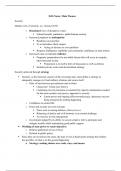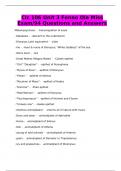ISSS Notes: Main Themes
Security
Modern view of security: (re: Omand 2010)
o Broadened view of disruptive events
Natural hazards, pandemics, public/human security
o Increased emphasis on anticipation
Readiness in peacetime
To avoid/reduce likely impact
Acting in advance to avert problem
Requires intelligence capability and community confidence in state actions
o Increased value on national resilience
Pragmatic preparedness for inevitable threats that will occur in complex,
interconnected society
Preparation is in itself a form of dissuasion as well as defence
Includes private sector and decentralised strategy
Security achieved through strategy
Security, as the foremost concern of the sovereign state, must define a strategy to
adequately manage civil and military relations and secure itself
o State of trust between governments and civilians
Clausewitz’ Trinity [see below]
Continuing trust in peacetime is essential for capacity-maintenance needed
for the more modern anticipatory approach to security
Latent power and ongoing effort towards peace, deterrence success
being measured by nothing happening
o Confidence in normal life
o Peace and security are twin concepts
Peace rests on strong defences (Siena fresco)
Balancing of justice and civil harmony is an eternal challenge
An exercise in risk management
o Government judged by its ability to use pre-emptive info to anticipate and
mitigate trouble whilst maintaining good public support
Wielding of state power to reach objectives
o Defines application of use of force
o Defined in public policy
Since they are not always the same, the type of war at hand needs strategy that reflects
the specifics of what is on the ground happening
o Strategy: making choices over ends, ways, and means
, o Defines limitations on use of force and conditions for employment
o Must consider:
End goal
Defeat: mental process, in battlefield or in non-battle aspects. Mass
destruction.
Destroy: absolute death. Politically and socially untenable, and
needs to destroy the enemy’s will.
Approach
Direct: face-to-face
Indirect: attack away from main target e.g. draw forces away, cut
communication
Stepping stones
Strategy: High political level, ends ways and means
Tactics: On the ground soldiers, abilities, assets that are used
Operational: In between, a link between strategic objective and
tactical activities
o How you synchronise and interact between activities to
multiple total effect of each individual activity
o A difficult art of coordination
Rules of Engagement
Codes of Conduct
Especially in combined operations, nations impose their own
caveats and red lines on the level of use of force
Caveat-matrix defines red lines for each member in regard to
collective action
(If allied operation), Interoperability
Cross-national military connections
o Radios, planning, equipment, ammunition and maintenance
Strategic studies: academic study of strategy
o “If warfare is a continuation of political intercourse, then studying warfare is a
means of studying the politics of conflict – and navigating the long road to
peace.”
Re: diplomacy and seeing diplomacy and military as two tools of the state
in tandem
Civil-Military Relations:
Security, to a large extent, is about the management of civil-military relations
o How does a government representing the citizenry interact with this instrument of
violence that armed forces are, that the government has created for itself?
Huntington’s “The Soldier and the State” (mostly Cohen’s nuanced analysis)
, o Core assumptions of standard model of civil-military relations:
Officership as a profession, in the management of violence
Ideal officer is a patriotic member of a brothership of arms
Group is prioritised over the individual
Built around notion of being the “specialists” in managing
violence to achieve desires in political outcomes
Military force is an instrument of policy, wielded in the service of the state
Re: Clausewitz’ trinity [see below]
Society and international relations, at heart, need civil-military relations to
provide order in society and in the international system itself
If not, those with guns are only intimidating and in need of being
controlled
o Asserts need to build military around notion of obedience
Chain of command facilitates functionality
o Asserts that a sharp distinction between civil and military competences produces
the ideal military performance
“Objective civilian control”
Strategy begins where politics ends
Military professionalism is best equipped to determine strategy
E.g. US military in WWII
Opposed to “subjective civilian control,” where this is not separated
o Criticised:
Unrealistically pristine theory
Ambiguous and politically defined goals produce non-static
purpose
Does not confront real and messy problems of war
Unclear distinction between competences, and military or non-military
organisation
Professionalism has limits
Technical expertise is necessary but not absolute; it is job-specific
“Management of violence” excludes large areas of military activity
War is too varied an activity
Wartime pressures cause civilians to be mostly unable to control the
military realm, or confine it to politics
Military officers do not always follow his chivalric ideal-type of who
these specialists are
Assumption of rationality under question, but strategic nihilism reminds us
that we cannot assume constant or permanent rationality
In practice, the law codifying civil-military relations differs in the degree of civilian
control over the military
, o In Belgium, military forces are subordinated to executive as per the constitution.
This is in turn controlled by parliament, through statutes, personnel law, and
budget
o French executive control is a lot more, with less say by the parliament
o Germany has more parliamentary control and less discretionary power by
executive
Degree of democratisation of society reduces risk of military overthrowing government
States:
National security: main concern
o Insecurity is the foundation of government
Basic organisation of states
Providing security as a public good to citizens
Centrality of states in architecture of security governance
Complimentary roles of international organisations
o Within a secure state, abundance, wealth, harvest, etc. has the opportunity to
flourish (harmony, security, prosperity)
Re: the Allegory of Good and Bad Government, Siena by Ambrogio
Lorenzetti video (1338/9)
Constant visual reminder to the obligations of the ruling council
Wise government represents common good, with subordinated
private interest
Peace rests on strong defences, and must be continually fought for
o National security is reliant on governments correctly employing its instruments of
the state
To create solutions for allowing the state to live with inherent security
threats
National Security Councils
Synchronises inventory of tools used to manage international
relations
(Armed forces, diplomacy, IOs, internal security, nurtured by
Intelligence Agencies)
Statecraft: managing the ship of the state
o External
To ensure positive relations with foreign states
Concerned with international system and threats from abroad
MFA
Armed forces
MoD
Intelligence Agencies





